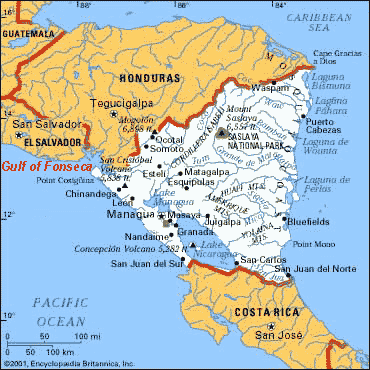In early 1913, while William Howard Taft was still in the White House, the United States was granted a 99-year lease on two Nicaraguan islands (Great Corn and Little Corn islands in the Gulf of Fonseca) as the sites of possible future naval bases. Of greater importance was the granting of a perpetual option to purchase the Nicaraguan canal site.
 The canal project in Panama was nearing completion at the time and there was no need for the U.S. to contemplate two such massive projects. The clear intent was to exercise the option only in the event that another nation showed interest in the Nicaraguan route.
For these rights, the United States was to pay $3 million, roughly the same amount that Nicaragua owed to American private investors. Final action on this agreement was not completed by the Taft administration.
Incoming :President Wilson and Secretary of State William Jennings Bryan faced a dilemma. Approval of this agreement with Nicaragua would clearly be an exercise in Dollar Diplomacy, but the advantages to the U.S. were undisputed. In the end, pratical considerations won out and Bryan completed the treaty — a prime illustration of how the reality of power often overcomes idealism.
This treaty was roundly condemned by several other Central American nations; their opposition was affirmed by a decision of the Central American Court of Justice, but that decision was ignored by Nicaragua and the U.S.
The canal project in Panama was nearing completion at the time and there was no need for the U.S. to contemplate two such massive projects. The clear intent was to exercise the option only in the event that another nation showed interest in the Nicaraguan route.
For these rights, the United States was to pay $3 million, roughly the same amount that Nicaragua owed to American private investors. Final action on this agreement was not completed by the Taft administration.
Incoming :President Wilson and Secretary of State William Jennings Bryan faced a dilemma. Approval of this agreement with Nicaragua would clearly be an exercise in Dollar Diplomacy, but the advantages to the U.S. were undisputed. In the end, pratical considerations won out and Bryan completed the treaty — a prime illustration of how the reality of power often overcomes idealism.
This treaty was roundly condemned by several other Central American nations; their opposition was affirmed by a decision of the Central American Court of Justice, but that decision was ignored by Nicaragua and the U.S.